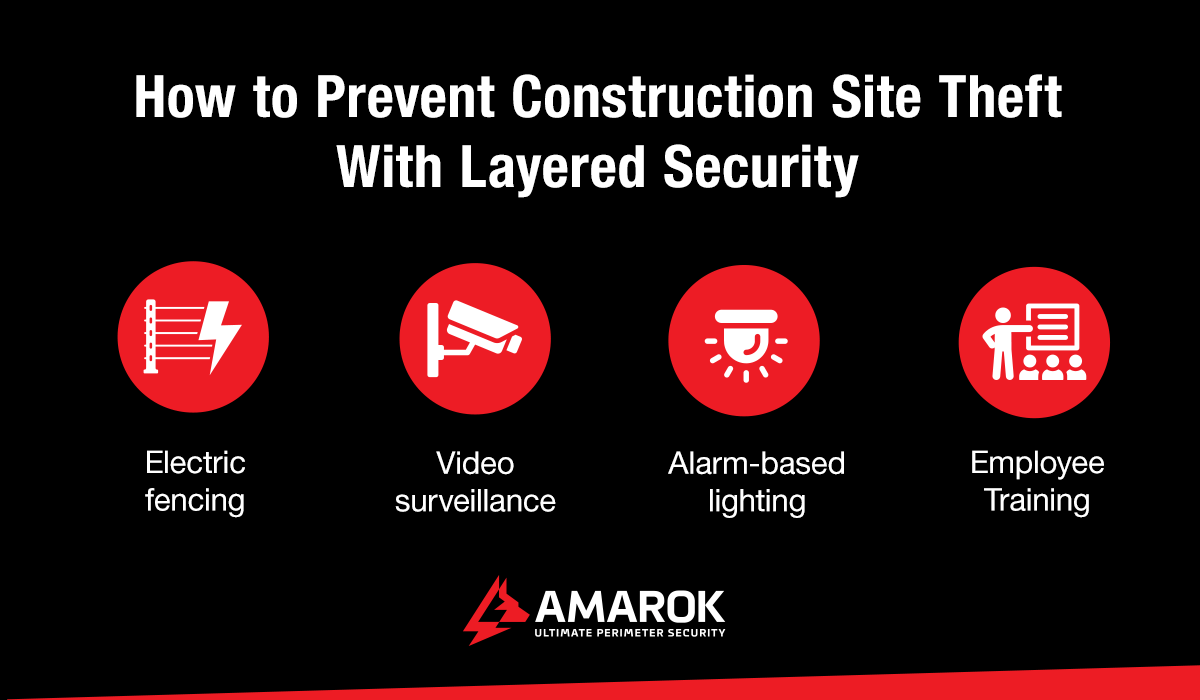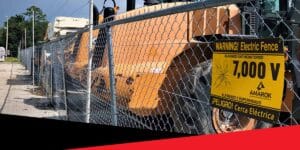Construction projects operate with tight margins, challenging timelines, and complex supply chains. A single incident of theft can disrupt this delicate balance and mean the difference between profit and loss.
Your building site assets are valuable and deserve the highest level of protection. And the reality is that theft at construction sites is common, with many reports indicating that incidents of theft are on the rise. If you’re in construction, protecting your jobsite is crucial to protecting your bottom line. This jobsite security guide will help you push back against crime and secure your site with perimeter security solutions.
The Need for Jobsite Theft Prevention
Construction site crime is frequent — for example, 2023 alone saw almost 13,000 burglaries at construction sites. Thieves target these sites due to several factors, including:
- Valuable assets: Construction materials and equipment are in high demand. Heavy equipment, tools, copper wire, and lumber can turn a lucrative profit when selling on the resale market. Once stolen, these assets can be difficult if not impossible to trace — in fact, 75% of stolen building materials and goods are never recovered.
- After-hours vulnerability: Sites are vulnerable when left unsupervised, especially after dark, on weekends, and during holidays. Active construction sites often have multiple entry points and lack the protection of a completed building, making them attractive targets for opportunistic criminals.
- Extensive inventories: Large amounts of materials and tools may be spread throughout the site, making it easier for intruders to access what they want and make a quick exit.
- Changing perimeter: Construction sites often encompass huge areas of land. As the project progresses, your site’s perimeter may also shift and scale. Without security measures in place, a fluctuating perimeter results in new ways for unauthorized individuals to gain entry.
What Are the Costs of Jobsite Theft?
In the U.S., the cost of heavy equipment theft is estimated to be up to $1 billion every year. This massive total excludes the cost of stolen hand tools, power tools, and building materials.
Beyond the value of the stolen property, theft can delay projects, costing a construction company thousands of dollars per day in liquidated damages and overheads. Additional costs come from raised insurance premiums, since even a single large claim for stolen property can increase premiums by 20%. If rental equipment is stolen from your building site, it can be challenging to secure rentals in the future. Reputational damage can also occur when theft causes a company to miss deadlines, eroding customer trust and compromising business deals.

How to Prevent Construction Site Theft With Layered Security
To protect your jobsite, assets, and equipment, the best solution is a construction site security plan that features multiple layers of defense. Take the following steps to invest in a stronger physical security infrastructure for your site:
1. Fencing
Electric fencing is the first step in strengthening your approach to perimeter security. For anyone attempting to breach the fence, a safe but memorable shock is enough to keep them out of your jobsite. Yellow signs with the universally recognized symbol for electrification also help you deter intruders while complying with safety standards.
Installed inside your existing fencing for longer jobs or more permanent sites, The Electric Guard Dog™ Fence delivers a 7,000-volt pulsed electric shock every 1.3 seconds, making it medically safe. For additional customization, Day Mode allows you to keep your fence pulsing at 1,000 volts during business hours, then increase to the full 7,000 volts after your crews leave for the night.
For temporary jobs or sites where the perimeter changes frequently, portable electric fencing ensures your equipment and materials stay protected as construction goes on.
2. Video Surveillance and Remote Monitoring
While video cameras won’t stop a criminal in the act, they do offer several security benefits for your jobsite in addition to electric fencing. Capture criminal activity with compelling surveillance footage to support insurance claims and investigations in the future. This footage can also serve as visual confirmation, which is required in certain jurisdictions before law enforcement will be dispatched to your site.
In addition to implementing a video surveillance system, remote and mobile monitoring offers real-time protection and around-the-clock coverage for your site. Gain peace of mind knowing there will be a quick response to suspicious behavior. Cloud-based software lets you monitor or access footage from multiple construction sites via a single dashboard.
3. Lighting
Criminals know how to exploit the cover of darkness as they attempt to access job sites. Alarm-based lighting provides an additional layer of security once your electric fence, surveillance cameras, and remote monitoring systems are in place. Experience unparalleled protection day and night with a wide range of options.
Zone fence lighting floods the area with light when the fence itself goes into alarm, while spot lighting is used to illuminate specific, high-risk parts of your site. Sentinels combine bright lights with loud sirens that turn on if the electric fence’s alarm is activated, drawing extra attention to dark or at-risk regions along your perimeter.
4. Employee Training
Your jobsite is safest when every worker has a shared sense of responsibility for protecting it. Effective employee training for construction site security includes:
- Recognition of suspicious behavior: Teach your construction crews to identify and report unusual activity, unauthorized individuals, or signs of tampering with equipment.
- End-of-shift procedures: Establish clear routines for securing tools, equipment, and materials at the end of each workday.
- Inventory management: Keep a detailed inventory of every piece of equipment and every tool to ensure records are up to date. This strategy may also include marking items with unique identifiers or investing in technologies like GPS tracking.
- Incident reporting: Explain how employees should report lost keys, missing tools, or any incidents.
- Emergency drills: Plan and practice safe drills for responding to robberies, intrusions, and emergencies.
Get the Jobsite Protection You Need With AMAROK
The best way to protect your construction site and your crews is with a layered security system that accounts for your site’s unique needs. At AMAROK, we start with a free threat assessment to assess risk holistically and evaluate your jobsite’s specific vulnerabilities. This step also includes an analysis of local crime data. Then, we work with you to create an integrated approach to physical security that safeguards your people, your property, and your profits.
Contact your local AMAROK representative for a free risk assessment today.






